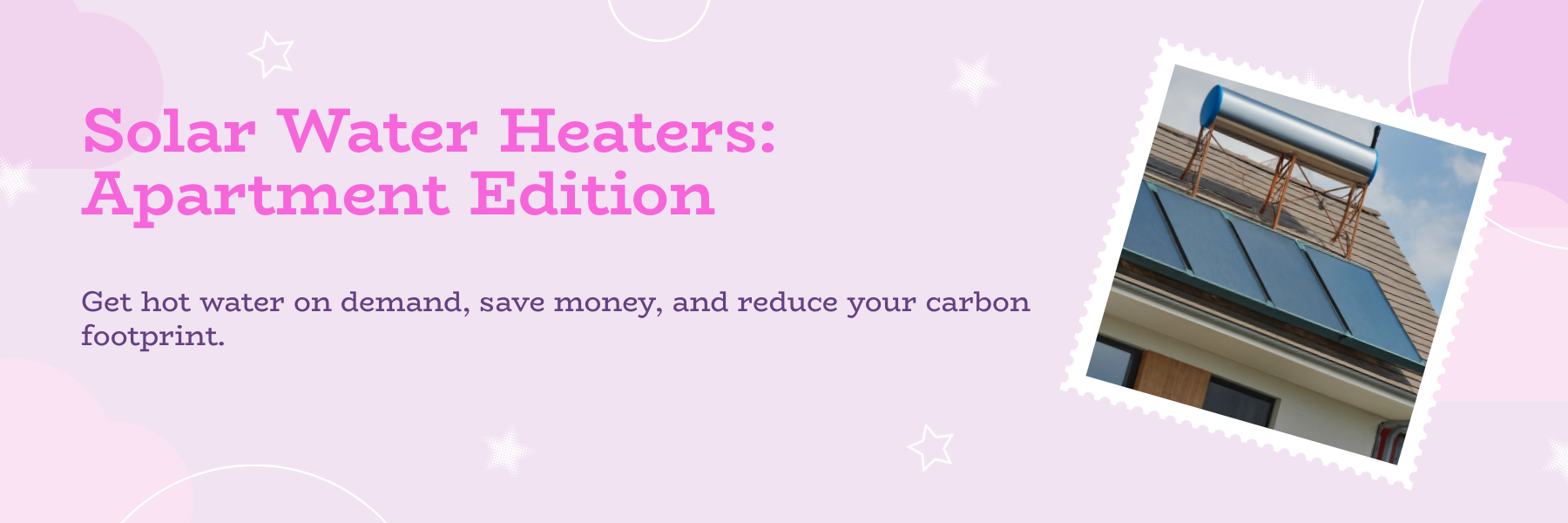
Varistor Solar is dedicated to empowering individuals, businesses, and communities with the transformative power of solar energy. We believe in a brighter, cleaner future and are committed to making sustainable living accessible to everyone.
+91-9113690456
Email: sales@varistorsolar.com
Varistor Solar
NO 40/C, KALKERE VILLAGE,12TH MAIN, NRI LAYOUT,Ramamurthy Nagar, Bangalore North,Bangalore- Karnataka, 560016
Choosing the right solar water heater for an apartment complex can be a daunting task, especially if you're new to the concept. In this comprehensive guide, we will break down everything you need to know about determining the appropriate LPD (liters per day) for a solar water heater plant in an apartment setting. We'll also touch upon the various factors that influence this decision, the benefits of using solar water heaters, and some practical tips to help you make an informed choice. Let's dive in!

Table of Contents
- Introduction to Solar Water Heaters
- Understanding LPD and Its Importance
- Factors Influencing LPD Requirements in Apartments
- Calculating LPD for Your Apartment
- Types of Solar Water Heaters
- Cost Considerations and Benefits
- Choosing the Right Solar Water Heater for Your Needs
- Installation and Maintenance Tips
- Conclusion
Introduction to Solar Water Heaters
What is a Solar Water Heater?
A solar water heater is a system that uses solar energy to heat water for domestic or commercial use. Unlike traditional water heaters that rely on electricity or gas, solar water heaters are eco-friendly and can significantly reduce your energy bills. They are especially beneficial in sunny regions where solar energy is abundant.
Why Use a Solar Water Heater in Apartments?
Solar water heaters are not just for individual homes; they are highly effective in apartment complexes as well. Here’s why:
- Cost Savings: Solar water heaters can drastically cut down on electricity or gas bills.
- Environmental Impact: Reduces carbon footprint by using renewable energy.
- Reliability: Provides a consistent supply of hot water even during power outages.
- Long-Term Investment: Increases property value and offers long-term savings.
Understanding LPD and Its Importance
What is LPD?
LPD stands for "liters per day" and refers to the amount of hot water a solar water heater can supply in one day. This metric is crucial in determining the right size of the solar water heater for your apartment.
Importance of Correct LPD Calculation
Accurate LPD calculation ensures that:
- Sufficient Hot Water Supply: Meets the daily hot water needs of all residents.
- Cost Efficiency: Avoids overspending on a larger system than necessary.
- Optimal Performance: Ensures the system runs efficiently without strain.
Factors Influencing LPD Requirements in Apartments
Number of Residents
The most obvious factor is the number of residents. More residents mean a higher demand for hot water.
Usage Patterns
Different households have varying hot water usage patterns. Factors such as the number of bathrooms, frequency of bathing, dishwashing, and laundry impact the LPD requirements.
Climate and Location
In colder regions, the demand for hot water will be higher compared to warmer climates. For instance, solar water heater in Bangalore price may differ from solar water heater Jaipur due to climatic conditions.
Types of Users
Different user groups have different hot water needs. For example, a solar water heater in a hospital or a solar water heater in Guest house may require a different LPD calculation compared to a standard apartment.
Peak Usage Times
Understanding peak usage times helps in determining the capacity needed to ensure an uninterrupted supply during high-demand periods.
Calculating LPD for Your Apartment
Step-by-Step Calculation
- Assess Daily Usage: Estimate the daily hot water usage per person.
- Multiply by Number of Residents: Calculate the total daily usage for all residents.
- Factor in Usage Patterns: Adjust for variations in usage patterns.
- Consider Peak Usage: Ensure the system can handle peak usage times.
Example Calculation
Assume an apartment with 20 residents:
- Average Usage per Person: 50 liters/day
- Total Usage: 50 liters x 20 residents = 1000 liters/day
In this case, a 1000 LPD solar water heater system would be needed to meet the demand.
Types of Solar Water Heaters

Flat Plate Collectors (FPC)
FPCs are widely used and consist of a flat plate absorber that collects solar energy and transfers it to the water.
Evacuated Tube Collectors (ETC)
ETCs are more efficient, especially in colder climates, and consist of multiple glass tubes that absorb solar energy.
Integrated Collector Storage (ICS)
ICS systems are simple and cost-effective, combining the collector and storage tank in one unit.
Pressurized vs. Non-Pressurized Systems
- Pressurized Systems: Ideal for buildings with multiple floors, providing consistent water pressure.
- Non-Pressurized Systems: Suitable for single-story buildings or where water pressure is not a concern.
Solar Water Heater PG
Solar water heater PG (Pressure Gradient) systems are designed to handle high-pressure requirements, making them suitable for multi-story apartments and buildings with varying water pressure needs.
Cost Considerations and Benefits
Initial Investment
The initial cost of a solar water heater can vary based on the type, size, and brand. For instance, solar water heater 200 litre price can range significantly depending on the manufacturer and features.
Long-Term Savings
Despite the higher upfront cost, solar water heaters offer substantial long-term savings on energy bills.
Environmental Benefits
Solar water heaters reduce reliance on fossil fuels, cutting down on greenhouse gas emissions and promoting a sustainable lifestyle.
Government Incentives
Many governments offer incentives and rebates for installing solar water heaters, further reducing the overall cost.
Varistor Solar: Leading the Way
Varistor Solar offers a range of solar water heaters tailored to different needs, ensuring high efficiency and reliability. Their products are known for their durability and advanced technology.
Choosing the Right Solar Water Heater for Your Needs
Assessing Your Requirements
Understand your daily hot water needs, climate conditions, and budget to choose the right system.
Comparing Options
Compare different types of solar water heaters, such as flat plate collectors and evacuated tube collectors, to find the one that best suits your requirements.
Evaluating Brands
Look for reputable brands like Varistor Solar that offer high-quality products and reliable customer support.
Reading Reviews
Check reviews and testimonials from other users to gauge the performance and reliability of the systems you are considering.
Consulting Experts
Seek advice from solar energy experts to ensure you make an informed decision.
Installation and Maintenance Tips
Professional Installation
Always hire professional installers to ensure the system is set up correctly and safely.
Regular Maintenance
Regular maintenance, such as cleaning the collectors and checking for leaks, ensures the system runs efficiently.
Monitoring Performance
Keep an eye on the system’s performance and address any issues promptly to avoid disruptions.
Utilizing Support
Take advantage of the customer support services offered by manufacturers like Varistor Solar for any maintenance or repair needs.
Understanding Warranty Terms
Familiarize yourself with the warranty terms and conditions to understand what is covered and for how long.
Conclusion
Choosing the right LPD for a solar water heater plant in an apartment involves careful consideration of various factors, including the number of residents, usage patterns, and climate conditions. By understanding these factors and following the guidelines provided in this guide, you can make an informed decision that ensures sufficient hot water supply, cost savings, and environmental benefits.
Investing in a solar water heater is a smart choice for apartment complexes, offering long-term savings and promoting sustainability. Brands like Varistor Solar provide reliable and efficient solar water heaters that cater to various needs, ensuring you get the best value for your investment.
Frequently asked Questions
LPD stands for "liters per day," indicating how much hot water the system can provide daily.
Estimate daily hot water use per person, multiply by the number of residents, and adjust for peak usage times.
It depends on your needs, but pressurized systems like those offered by Varistor Solar are great for multi-story buildings.
Yes, it offers long-term savings on energy bills and reduces environmental impact.
Regular cleaning of the collectors, checking for leaks, and monitoring performance are essential for efficient operation.
Now It's Your Turn:
Making the switch to solar water heaters in Delhi is a smart and sustainable choice. The top brands like Varistor Solar™, Racold, Havells, V-Guard, and AO Smith offer reliable options to meet your hot water needs efficiently.
Among these, Varistor Solar™ stands out as the top choice in India, trusted by many. We provide a variety of solar water heaters, catering to different preferences and requirements. Our clients trust us for our quality and performance.
For more details about our solar water heaters, call us at 9113690456 or email sales@varistorsolar.com. Choose Varistor Solar™ for a greener and more energy-efficient future.
"WHAT YOU CAN READ NEXT"
 Read more +03 September 2024 in Solar Water Heater
Read more +03 September 2024 in Solar Water HeaterWhich is the Best Solar Heater Brand in Yeshwanthpura, Bengaluru
 Read more +03 September 2024 in Solar Water Heater
Read more +03 September 2024 in Solar Water HeaterWhich is the Best Solar Heater Brand in Yelchenahalli, Bengaluru
 Read more +03 September 2024 in Solar Water Heater
Read more +03 September 2024 in Solar Water Heater




